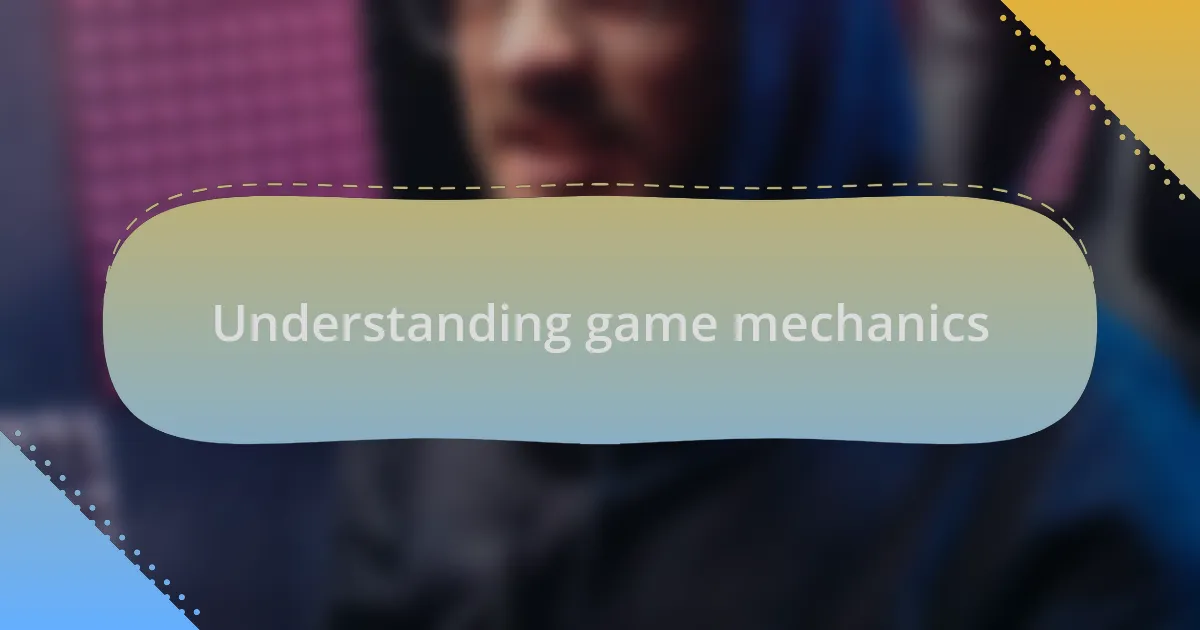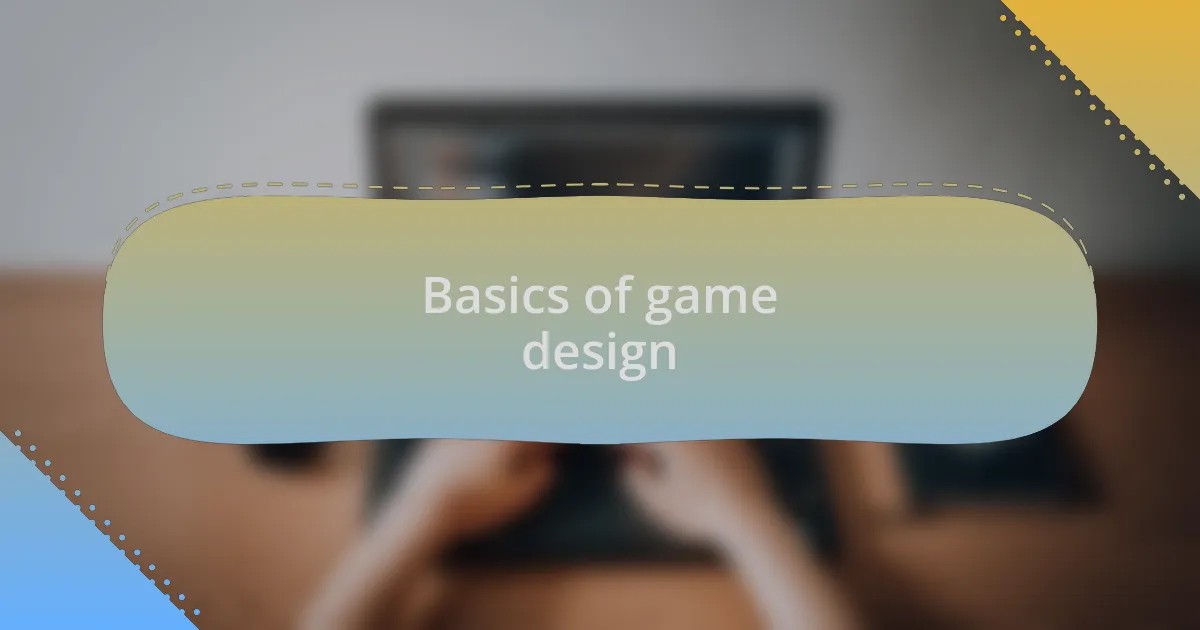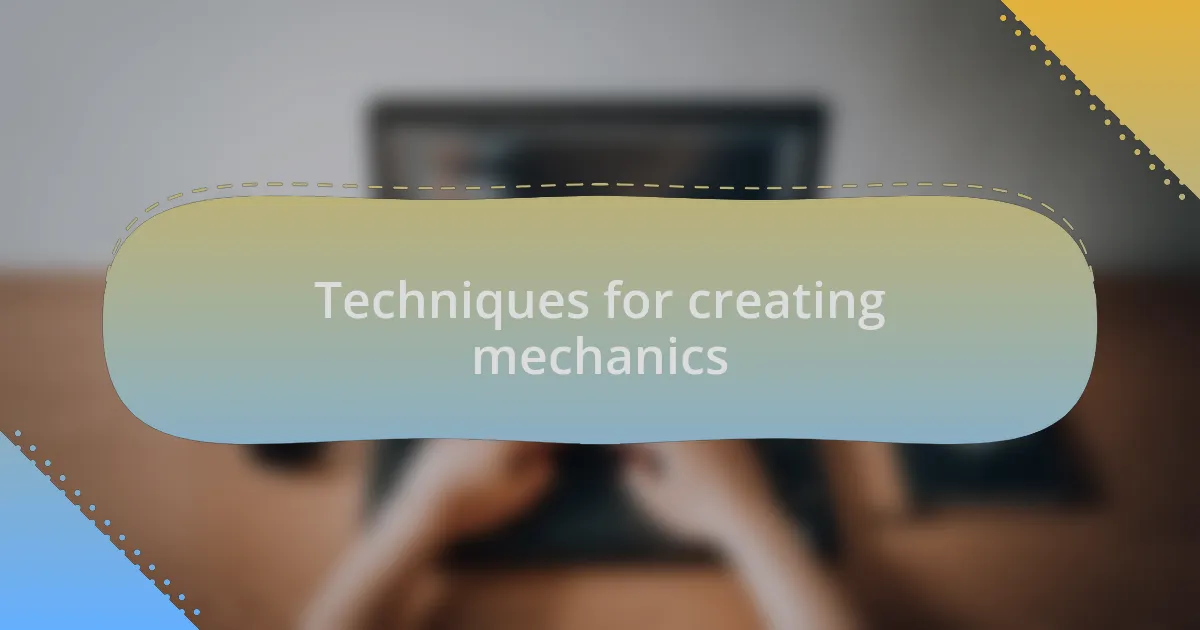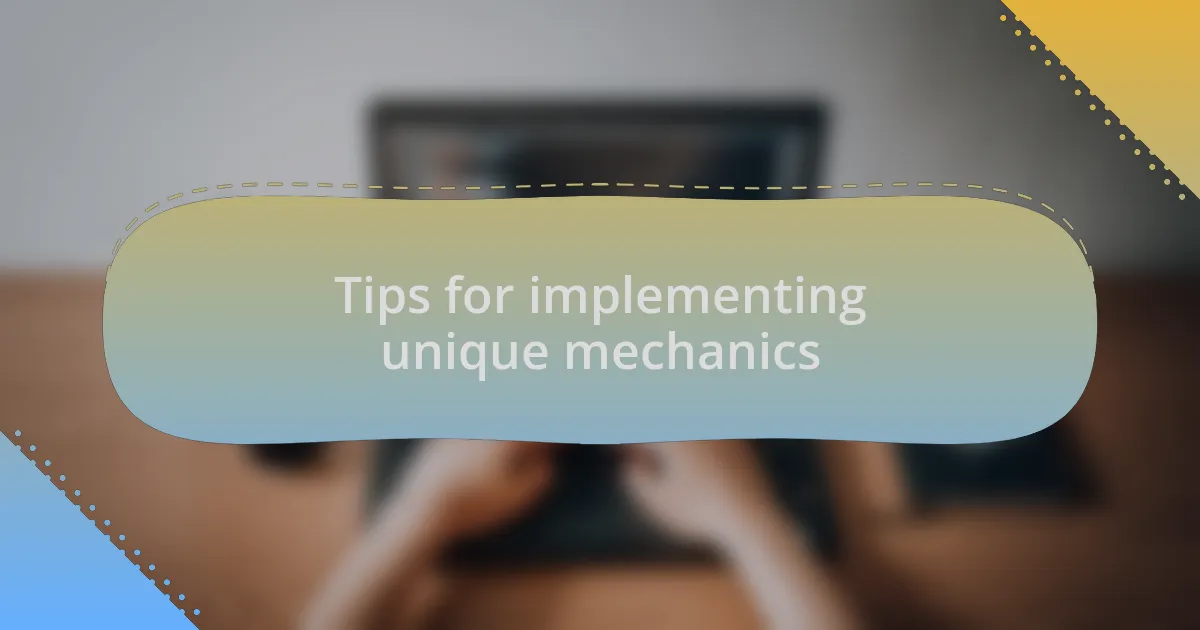Key takeaways:
- Game mechanics significantly influence player experience and emotional engagement; small adjustments can have profound effects.
- Creating unique mechanics sets a game apart and can evoke strong emotional responses, fostering deeper connections with players.
- Iterative design and player feedback are essential for refining game mechanics and ensuring they resonate with the audience.
- Encouraging player creativity and simplifying complex systems can lead to more engaging gameplay experiences.

Understanding game mechanics
Game mechanics are the rules and systems that govern the interactions within a game. When I first started developing games, I was fascinated by how small adjustments to these mechanics could drastically alter the player experience. Have you ever noticed how a simple tweak in difficulty can turn a casual game into an exhilarating challenge?
Understanding game mechanics also involves recognizing how they connect with player motivation. For instance, I remember designing a puzzle game where I introduced a time limit for each level. At first, I thought it would create tension, but I realized it also stressed players out, detracting from the fun. This taught me that the emotional response of players to mechanics is just as crucial as the mechanics themselves.
Each mechanic serves a purpose and shapes the narrative flow of a game. Reflecting on my journey, I often ask myself: how do these mechanics encourage exploration, risk-taking, or collaboration? For example, when I incorporated a cooperative mechanic in a multiplayer game, I witnessed players not only working together but also forming friendships. This highlighted how mechanics can foster community, making us rethink what we want players to experience.

Importance of unique mechanics
Creating unique game mechanics is critical in distinguishing your game from the plethora of options available today. I remember when I was developing a platformer game, and I decided to introduce a mechanic that allowed players to bend gravity. This innovation didn’t just set the gameplay apart; it fundamentally changed how players interacted with the environment, making them rethink their approach and strategies. Have you ever played a game that made you feel like you were part of something entirely new? That’s the excitement I aim for with unique mechanics.
The emotional resonance of unique mechanics cannot be understated. In a strategy game I once worked on, I introduced a mechanic that allowed players to make moral choices, impacting not just the game’s outcome but also the player’s connection to the story. I noticed players became deeply invested, often discussing their decisions long after gameplay. It made me realize: when mechanics evoke emotions, they create memorable experiences that players carry with them.
Moreover, unique mechanics can serve as a catalyst for community engagement. I’ve seen it firsthand in a game where players could design and share their own levels, driven by a powerful creation mechanic. This interaction sparked creativity among players, encouraging collaboration and showcasing their personalities. How often do we see a game evolve into a community-driven phenomenon because of a single, innovative mechanic? It’s fascinating how these choices can lead to thriving, engaged communities.

Basics of game design
When considering the basics of game design, it’s essential to understand the core elements that make a game engaging. For me, it all starts with mechanics, dynamics, and aesthetics—the foundational triad. I remember during a game jam, I focused on how these elements interplay; I noticed that a simple tweak in mechanics could lead to a completely different player experience. It’s fascinating to see how minor adjustments can transform a mundane task into an exhilarating challenge.
Furthermore, understanding your target audience can significantly influence your design choices. I once developed a puzzle game intended for casual gamers. By integrating intuitive mechanics that felt rewarding rather than punishing, I saw players return time and again. This taught me the importance of aligning mechanics with player expectations. Have you ever played a game that felt just right for you? That’s the magic of designing with an audience in mind.
As I delve deeper into game design, I often reflect on the emotional journeys games can create. In one of my projects, I designed a mechanic where players could express themselves through in-game choices. The feedback from players was overwhelmingly positive; they not only enjoyed playing but also felt a personal connection to the outcomes. It made me realize that the basics of game design aren’t just technical; they also encompass the emotional landscapes we can create. How can we make our players feel more invested in their journeys? This question drives my design philosophy.

Tools for game development
When it comes to game development, having the right tools can make all the difference. I’ve used engines like Unity and Unreal Engine extensively, and each has its strengths. Unity, for instance, is fantastic for 2D games and offers a wealth of resources for beginners, while Unreal’s stunning graphics really shine in 3D environments. Have you ever considered how the tool choice impacts creativity? It’s like painting; the right brush can bring your vision to life.
Moreover, don’t overlook the importance of auxiliary tools. I often rely on software like Blender for 3D modeling and Aseprite for sprite creation. The feeling I get when I see a character I sculpted come to life in a game is unmatched. Additionally, integrating tools like Git for version control has saved my team from many headaches, ensuring smooth collaboration. In my experience, combining creative tools with efficient workflow software is vital for staying organized and focused.
Lastly, I can’t emphasize enough the value of prototyping tools. During a recent project, I used Figma to draft quick interfaces for my game, enabling me to test concepts rapidly. It was incredible to gauge reactions from peers based on just a few screens. Wouldn’t it be awesome if every development phase felt this interactive? Embracing these tools not only streamlines the process but also fosters a collaborative atmosphere where ideas can flourish.

Techniques for creating mechanics
When I think about creating unique game mechanics, one technique I’ve found effective is iterative design. This approach reminds me of sculpting; you chip away at a block of stone until the desired shape emerges. For instance, during the development of my last game, I started with a basic mechanic and then refined it through constant playtesting. Each iteration revealed unexpected interactions, pushing the boundaries of what I initially imagined. Have you ever noticed how a simple tweak can completely transform gameplay?
Another technique that has served me well involves blending genres to inspire fresh mechanics. I recall working on a project where I combined elements of a puzzle game with traditional platformer mechanics. This fusion offered players new challenges and kept them engaged longer than I expected. It’s fascinating how cross-pollinating ideas can lead to innovative gameplay experiences. Have you experimented with mixing genres in your projects?
Finally, user feedback is a critical part of my process. I remember the excitement of presenting my prototype at a local game jam; the insights from players were invaluable. They pointed out aspects I never considered, which led to a profound rethinking of the gameplay flow. How essential do you find player feedback in your development journey? Embracing constructive criticism can unveil opportunities for growth and creativity, ensuring that your mechanics resonate with your audience.

Personal experience in game mechanics
When I reflect on my journey with game mechanics, one standout moment was experimenting with physics-based elements. I integrated ragdoll physics into a platformer, which led to unexpected hilarity. I vividly remember the first time a character tripped and tumbled in a way I hadn’t planned; it was both amusing and deeply satisfying. How often do we stumble upon fun surprises that reshape our understanding of player experience?
There was also a time when I introduced a mechanic that allowed players to manipulate time within the game. The complexity of balancing this feature felt daunting at first, but I was inspired by old classics that utilized time manipulation. The moment my playtesters began brainstorming their strategies around this mechanic, I felt a rush of joy. Can you recall a time when a new feature transformed not just gameplay, but also your perspective on what’s possible?
Finally, I’ve learned the hard way that not all unique mechanics will land. During one project, I tried to innovate with a resource-gathering system that was too convoluted. I remember the blank stares from my friends during the demo; it was a gut-wrenching experience. Yet, in that failure, I found the seeds for simplicity, realizing that sometimes the best mechanics are those that are easy to grasp. Have you ever had a similar experience where a misstep turned into a valuable lesson?

Tips for implementing unique mechanics
When implementing unique mechanics, it’s crucial to start small and iterate. I fondly remember the early days of developing a stealth mechanic where shadows played a pivotal role. I initially imagined a complex system, but simplifying it to just a few clear interactions made it immensely more engaging. Have you ever realized that sometimes less truly is more?
Another effective strategy is to encourage player creativity. In one game, I designed a crafting system that allowed players to combine unexpected items. Watching players invent outrageous solutions to challenges was thrilling. How often do we underestimate the power of letting players surprise us with their ingenuity?
Finally, playtesting is invaluable when introducing new mechanics. I recall a session where I introduced a quirky, gravity-defying jump feature. At first, players were confused, but their feedback led me to tweak the mechanic to enhance intuitiveness. It made me wonder: what could I have missed if I hadn’t engaged with my audience?